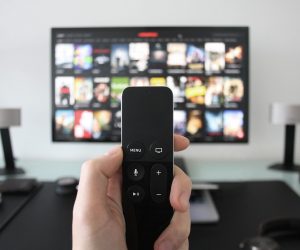Introducing the next generation of TV
It might not seem like it but one of the key things people do on the Internet is releasing and (others) watching entertainment products. Whether it’s a podcast, audiobook, news story, Vimeo self-made video or a Netflix series, the internet is rapidly becoming a the place we all go to when we’re looking to pass time enjoyably.
The history of the internet has, in many ways, been driven by the bandwidth that was available on it, to distribute these forms of entertainment. In the early days of the net, dial up modems screeching provided text forums and articles to the early adopters who were using it at the time and VERY slow to load images – for the patient. Then home broadband arrived, albeit at lower speeds than we’re used to now. MP3 ‘sharing’ (theft) took off and low resolution videos became available on YouTube. Not long thereafter, 3G mobile data technology bought the rudiments of mobile video and ‘Facetime’.
Now, it’s commonplace for entertainment services to be delivered over IP (Internet) networks, rather than Over The Air (OTA) broadcast radio frequencies. And here comes 5G. Commercial deployment will begin this year all over the world. 5G phones will hit the streets. And the incredible speeds and new transmission capabilities it offers will cement the importance of Internet based TV.
What Exactly is 5G TV?
5G is superfast mobile data. To give you some idea of just how fast 5G is, at current 4G speeds, it might take about 30 seconds to download a standard resolution TV show. With 5G, you’ll be able to download every episode ever made of Game of thrones in High Resolution, in less than 10 seconds.
5G will make downloading and watching TV on your handset so easy and reliable, it will become even more commonplace than it is now.
How much is 5G TV worth?
The worldwide value of the global TV market is shared between cable and terrestrial broadcast. In total, it’s worth about $600 billion. 5G TV is on the brink of completely disrupting it. And, as usual, when you lift the cover on who’s disrupting, it’s Google, Facebook and the other digital first players.
Facebook are already bidding on the licenses for football. Interestingly, however, the market will be served with content beyond what we used to watch. It’s no longer necessary to serve just the lowest common denominator with broad reach programming. 5G will fuel niche interests such as the growing range of televised e-sports (watching others play video games), for example.
And you won’t even have to foot the bill for delivery
An increasing proportion of phone plans are now provided with free (also known as zero rated) data for particular service uses. For example, a phone company might give you 10GB of 4G data per month to use – but also let you watch as much sport as you want to on your phone. The data you use to watch the sport won’t count against that 10GB allowance.
5G has also been designed with the lessons learned from 4G, in mind. 5G will build on a little known capability of 4G networks called LTE-B. LTE-B involves the broadcast of a single signal that is then picked up by all the phones in an area. Think about being at a live sporting event and everyone in the audience being able to watch the replays live on their handset – or an emergency situation in which authorities want to communicate evacuation information.
Bringing it all together
More than anything, 5G solves many of the problems that previous data carriage technologies provided. 5G has so much bandwidth that TV shows can be downloaded in moments, when the user is in coverage and played for hours when the user is outside it, without ever interrupting viewing.
Internet smarts have driven a trend towards personalized services. Algorithms now recommend TV shows that we might like to watch and, of course, adverts for products we might like to buy. 5G means that, whenever we’re mobile, we can be connected to the internet and stream TV over our IP connection. The TV channels we will watch will be personalized playlists prioritized according to our preferences and moods. They’ll often be paid for by targeted ads which know us better than the commercials we used to watch on the tube.
